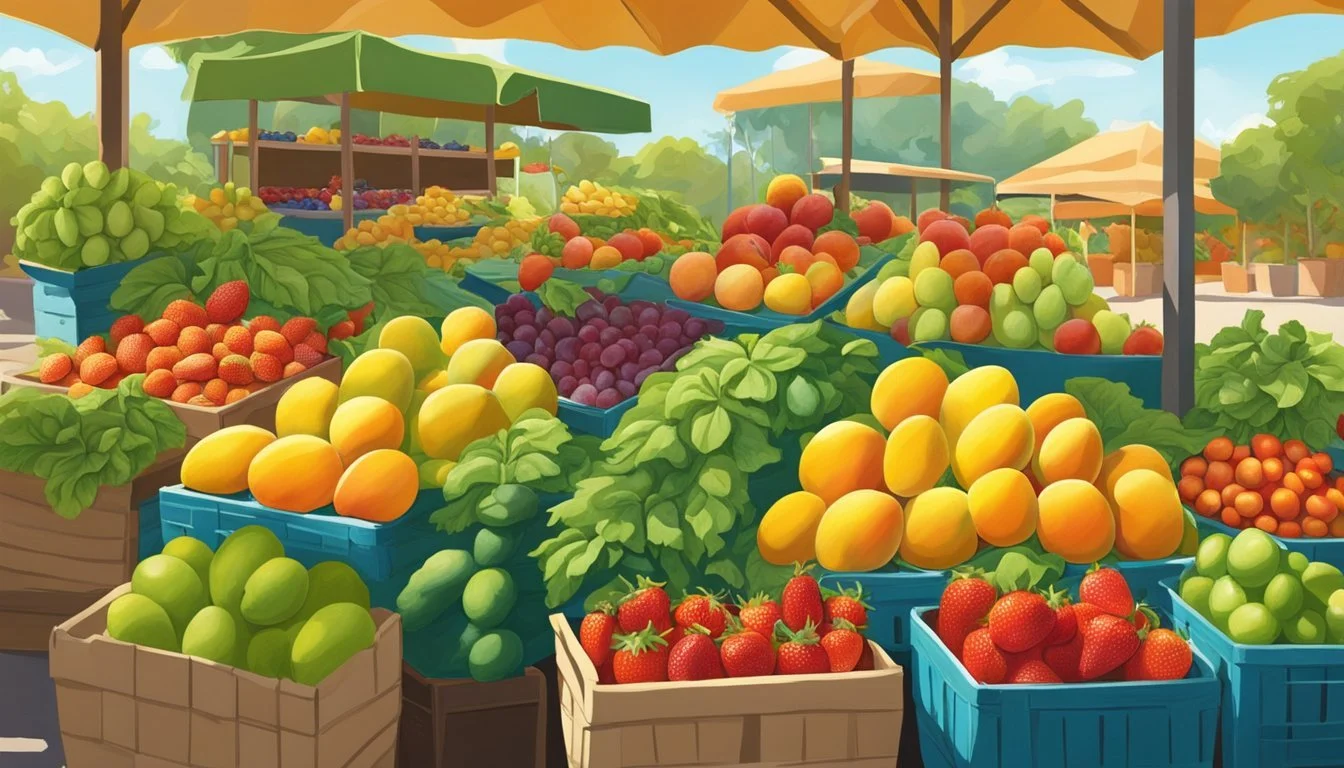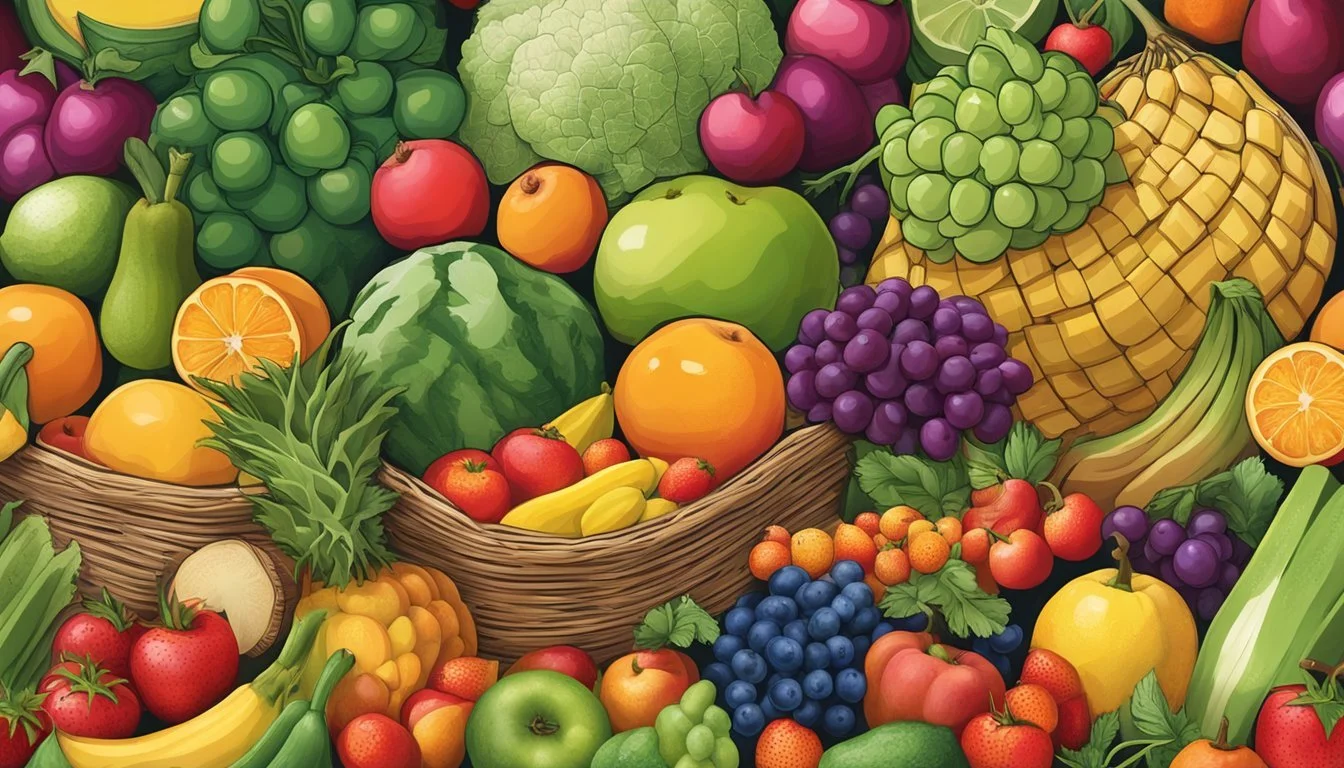Florida Seasonal Fruit & Vegetables in May
Your Ultimate Guide to Fresh Produce
This Article is Part of our Florida Seasonal Fruit & Veg Calendar
May in Florida heralds a period of abundant harvests, where the variety of fruits and vegetables available is reflective of the state's diverse agriculture. This month, consumers can expect a wide selection of fresh produce, harvested at the peak of its flavor and nutritional value. The warm climate of Florida allows for an extended growing season, which means that some crops that might have ended in other regions are just hitting their stride in the Sunshine State.
Key produce to look for during this time includes blueberries, which are rounding off their season, and vegetables like sweet corn and tomatoes that are just beginning to hit the market stalls. Citrus fruits, a staple of Florida agriculture, remain available, offering juicy oranges and tangerines. This is also an excellent time for avocados and mangos, which add a tropical flair to the seasonal selection.
As consumers shop for produce in May, they will find that Florida's offerings are not just limited to well-known staples. The state's farmers markets and grocery stores may also feature lesser-known gems such as snap beans, cucumbers (how long do cucumbers last?), and radishes, ensuring that there is always something new to discover within Florida's seasonal bounty. The focus on locally sourced and seasonally appropriate produce supports the local economy and provides a fresher, tastier experience for the consumer.
Overview of Florida's Seasonal Produce
May in Florida is not just a time of year; it's a vibrant showcase of agricultural bounty. The month's seasonal produce is a testament to the state's unique climate, offering a variety of fruits and vegetables at their peak freshness and flavor.
Importance of Seasonality
Consumers often seek out produce that tastes better, is more nutritious, and has a lower environmental impact. Seasonal produce meets these demands, being harvested at the optimum time for taste and nutritional content. Additionally, purchasing seasonal fruits and vegetables supports local economies and reduces the carbon footprint associated with transportation of out-of-season imports.
Florida's Agricultural Climate
Florida's climate is conducive to a year-round growing season for many crops. The state's warm temperatures, abundant sunshine, and generally mild winters create an environment that supports a wide variety of fruits and vegetables. In May, Florida's agricultural output is in full swing, taking advantage of the late spring climate before the onset of the hot, humid summer.
Fruits in Season in May:
Blueberries
Dragon fruits
Mangoes
Peaches
Vegetables in Season in May:
Cilantro
Corn
Cucumbers
Eggplant (What wine goes well with eggplant?)
Sweet Corn
Tomatoes
The availability of specific crops may vary slightly based on the region within Florida, as local microclimates can influence the growing season. However, consumers across the state can enjoy a diverse selection of fresh, in-season produce throughout the month.
Fruits In Season for May
In May, Florida's agricultural abundance is showcased through a variety of fresh, in-season fruits, ranging from sweet berries to tropical delights.
Citrus Varieties
Florida's citrus season is still vibrant in May, offering juicy oranges which include varieties like Valencia. The state's famous citrus bounty is beginning to wind down, so it's a prime time to enjoy the last of the season's freshest flavors.
Berry Selection
Blueberries and strawberries are at their peak of ripeness in May. Florida blueberries are especially sought after during this time for their plumpness and sweet taste. The strawberry harvest is also in full swing, providing ripe, red, and juicy berries perfect for a variety of dishes.
Tropical and Exotic Choices
May is an ideal month for tropical fruit lovers. Mango trees begin to produce their luscious fruits, while the exotic lychee starts its short but sweet season. Papaya and guava continue to thrive, offering a taste of the tropics that pairs well with the rising temperatures.
Melons
This month ushers in the start of melon season with watermelons and cantaloupes making their seasonal debut. These melons are known for their hydrating properties and refreshing taste, providing a succulent escape from the warm spring sun.
Vegetables Available in May
May in Florida presents a bounty of ripe vegetables for picking. During this time, farmers' markets and grocery stores are replete with an array of fresh produce ready for your table.
Leafy Greens & Herbs
Florida offers a variety of leafy greens and herbs in May. Shoppers can find robust collard greens (how long do collard greens last?) and lettuce, staples for salads and side dishes. Herbs like cilantro, oregano, and thyme are also plentiful, adding fresh flavors to any dish.
Collard Greens
Lettuce
Cilantro
Oregano
Thyme
Root Vegetables & Tubers
Root vegetables flourish in May's warm weather. Staple items such as radishes, carrots, and potatoes can be found readily. These root vegetables are versatile for cooking, whether roasted, mashed, or used in soups and stews.
Radishes
Carrots
Potatoes
Nightshades and Squashes
Nightshades like tomatoes and eggplant (What wine goes well with eggplant?) are becoming ripe in May, perfect for a variety of dishes from salads to grills. The versatile zucchini and squash make their seasonal appearance, ready to be turned into anything from side dishes to main courses.
Tomatoes
Eggplant
Zucchini
Squash
Legumes and Other Vegetables
In the legumes category, green beans peak in their seasonality. Among other vegetables, May signals the harvest for cucumbers, corn, and okra, each adding a unique taste and texture to springtime meals.
Green Beans
Cucumbers
Corn
Okra
Preparing Florida Seasonal Produce
In May, Florida's bounty includes a variety of fruits and vegetables ripe for culinary exploration. This section provides practical approaches for incorporating them into recipes, preserving their freshness, and understanding their health benefits.
Recipes and Uses
Florida's seasonal produce can be transformed into an array of culinary delights. For instance, blueberries are perfect for muffins, pancakes, or as a fresh snack. Broccoli (how long does broccoli last?) and cabbage can serve as robust additions to salads or stir-fries. Cantaloupes make refreshing smoothies or a sweet addition to breakfast. One can juice carrots for a nutritious drink or shred them for a vibrant salad.
Blueberry Smoothies: Blend with Greek yogurt and a drizzle of honey.
Carrot and Cabbage Salad: Shred and toss with a vinaigrette dressing.
Cantaloupe Juice: Puree cantaloupe; strain and serve chilled.
Preservation Techniques
Preserving Florida's seasonal produce ensures a household can enjoy their flavors long after the harvesting season. Freezing is an effective method for blueberries and broccoli, keeping them usable for months. Cantaloupes, can be cubed and frozen, although they may lose some of their crisp texture. Refrigeration in proper storage containers can extend the freshness of vegetables like cabbage and carrots.
Storage Guidelines:
Produce Technique Shelf Life Blueberries Freeze on a baking sheet Up to 6 months Broccoli Blanch, then freeze Up to 12 months Cabbage Wrap in plastic, refrigerate 1-2 weeks
Nutritional Benefits
The fruits and vegetables available from Florida in May not only offer versatility in the kitchen but also a range of health benefits. Blueberries are acclaimed for their antioxidant properties. Broccoli and cabbage are packed with vitamins C and K, fiber, and have been linked to a reduced risk of chronic diseases. Cantaloupes are an excellent source of Vitamin A and hydration, while carrots are rich in beta-carotene, beneficial for eye health.
Vitamin C: Found abundantly in broccoli and cabbage.
Beta-carotene: A precursor to Vitamin A, prevalent in carrots.
Antioxidants: Blueberries are among the highest in antioxidant content among common fruits and vegetables.
Supporting Local Agriculture
In Florida, the month of May blossoms with an abundance of local produce, offering consumers a chance to directly support the agricultural community. This section covers the key aspects of finding and purchasing local fruits and vegetables, detailing the benefits that come with this choice and exploring the role of governmental support in sustaining local agriculture.
Finding Local Produce
Consumers looking for fresh Florida produce in May can explore Community Supported Agriculture (CSA) or visit local farmers markets. By purchasing a CSA share, one can receive a weekly box of seasonal produce directly from local farmers. This method not only secures a variety of fruits and vegetables but also strengthens ties with the local farming community. Additionally, grocery stores often have sections dedicated to local produce, easily identified by tags or signs.
Benefits of Buying Local
When consumers choose local produce, they're not just buying fruits and vegetables; they're supporting the local economy and promoting sustainability. Here are some specific advantages:
Economy: Money spent on local produce circulates within the community, bolstering the financial stability of local farmers and contributing to job creation.
Sustainability: Local produce travels shorter distances to reach consumers, resulting in lower carbon emissions and fresher produce upon arrival.
Florida Department of Agriculture’s Role
The Florida Department of Agriculture and Consumer Services (FDACS) fulfills a crucial role in advocating for local agriculture. It provides resources that help consumers learn about Florida’s produce seasonal availability and encourages the integration of local products into grocery stores and restaurants. FDACS also ensures agricultural practices meet industry standards, which contributes to the overall health and sustainability of Florida's agricultural sector.
Seasonal Eating Tips
When it comes to enjoying Florida's produce in May, one should focus on what is fresh and available during spring. This month provides a multitude of options that can be maximized by shopping wisely and storing correctly.
Shopping Strategically
Local Markets: One will find the freshest produce by visiting local farmers markets. Items like blueberries, cantaloupes, and watermelon are in season and at their peak.
Blueberries: Available from April through June
Cantaloupes: March through July
Watermelon: Starts in April and peaks in June
Check for Freshness: Freshness is key for flavor and nutrition. Shoppers should look for vibrant colors and avoid produce with signs of wilting or bruising.
Storing Produce
Temperature and Humidity: Proper storage extends the life of produce. Keeping items like blueberries in a refrigerator and cantaloupes at room temperature until ripe helps maintain freshness.
Separate Ethylene Producers: Some fruits, like cantaloupes, produce ethylene gas, which can hasten ripening and spoilage in sensitive vegetables. They should be stored separately.
By employing these tips, consumers can make informed decisions that lead to enjoying the freshest and most flavorful produce that Florida's spring season has to offer.
Engagement and Further Resources
This section provides tools and strategies for enthusiasts to actively participate in exploring Florida's seasonal produce and to prepare for the bounty of upcoming months.
Interactive Resources
For those looking to engage more deeply with Florida's seasonal offerings, Pinterest offers a wealth of visual guides and infographics. Users can find boards dedicated to Florida produce with pins showcasing recipes, storage tips, and creative ways to use May's harvest. These visual resources are particularly helpful for identifying and preparing seasonal fruits and vegetables.
Planning for Upcoming Seasons
As May's peak season approaches, it's imperative to plan ahead for the freshest produce. Enthusiasts and consumers can consult interactive calendars and newsletters from local Florida agricultural resources to keep informed on what fruits and vegetables are coming into season. These guides are invaluable for meal planning, preserving, and taking full advantage of Florida's agricultural cycle.
Conclusion
May in Florida presents a variety of fresh produce full of flavor and nutrition. Consumers can find a selection of fruits and vegetables that are harvested at the peak of their season. The climate and soil conditions during this period offer optimal growing conditions for certain crops.
Notably, blueberries are rounding off their season, so it is an ideal time to enjoy their fresh, sweet taste. They can be found in abundance at local markets. For vegetables, broccoli retains its quality, giving salads and dishes both crunch and nutrients. Similarly, carrots and celery (how long does celery last?) are also at their best, offering crispness and versatility for cooking.
Here's a brief overview of some produce available:
Fruits: Blueberries
Vegetables: Broccoli, Carrots, Celery
Purchasing seasonal produce supports local farmers, ensures freshness, and often yields better flavors and textures. It can also be more environmentally friendly, as it reduces the carbon footprint associated with transporting produce over long distances.
Shoppers and chefs alike should take advantage of the season's offerings for both taste and nutritional benefits. With the knowledge of what is freshly available, they can make informed choices to enrich their culinary experiences.









